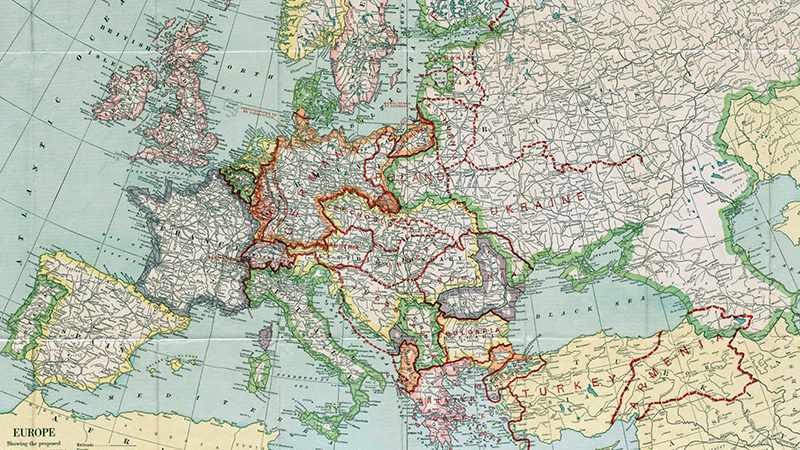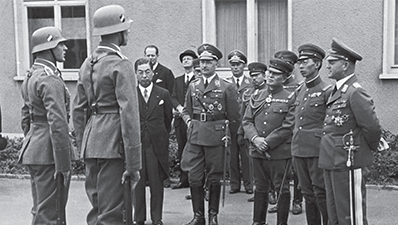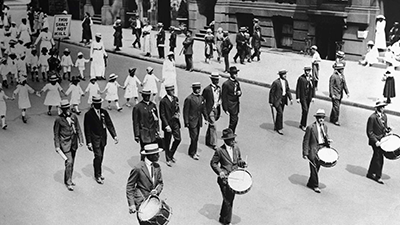Unresolved Tensions After World War I
Teacher Resources
Driving Question: In what ways did unresolved tensions from the interwar period shape future conflicts and territorial boundaries?
People experiencing the period between the two world wars did not know, of course, that they were living in a period between two wars. Many thought it still made sense to call the most recent conflict “the war to end all wars,” and hoped that international efforts for a lasting peace and prosperity would succeed. But the bitter losses suffered during the First World War, the punishments placed on the countries who were blamed for the war, and the attempt at reworking territorial holdings only served to fan, rather than snuff, the flames of conflict in the interwar period.
Learning Objectives
- Explain the continuities and changes in territorial holdings from 1900 to the present.
- Evaluate international cooperative efforts that arose because of, or in response to, the end of World War I.
- Analyze primary source documents to evaluate unresolved tensions during the interwar period.
Vocab Terms:
- authoritarianism
- diplomacy
- dual consciousness
- internationalism
- militarism
- self-determination
- treaty
Opener: Unresolved Tensions After World War I
To teach this lesson step, refer to page 3 of the Lesson 7.5 Teaching Guide.
Looking to save some paper while implementing this fun simulation? Look at the modifications teachers made in the Forum thread World War I Peace Talks Cards – Less Paper.
Countries were ready to give peace a chance at the end of World War I, but what did each side want in return for that peace?
Internationalism Between the Wars
To teach this lesson step, refer to page 7 of the Lesson 7.5 Teaching Guide.
The OER Project Video Guide provides great information on best practices for using video in the classroom.
In the 1920s, people around the world promoted international cooperation to prevent future wars, leading to efforts like the League of Nations and the Kellogg-Briand Pact. However, these internationalist ideals collapsed in the 1930s and failed to halt rising nationalism and authoritarianism.
-
Guiding Questions
-
Before you watch
Preview the questions below and then review the transcript.
While you watch
Look for answers to these questions:
- What was the Kellogg-Briand Pact?
- What were some attempts at internationalism during the 1920s?
- What are some examples of internationalism before the twentieth century?
- Why did the League of Nations fail?
- What does this video suggest is the legacy of the Kellogg-Briand Pact?
After you watch
Respond to the following questions:
- While the focus of this video is on international cooperation, how does it help to explain the causes of global conflict?
- How does the failure of internationalism aid your understanding of the causes of the Second World War?
- Can you think of any current examples of internationalism succeeding or failing?
Key Ideas
Source Collection: Unresolved Tensions
To teach this lesson step, refer to page 8 of the Lesson 7.5 Teaching Guide.
What led to World War II? These sources may provide some clues. As you read the primary source excerpts in this collection, use the accompanying Quick-Sourcing Tool and activity to guide your analysis.
Appeasement
Discover how efforts to keep peace through compromise ultimately shaped the path to another war.
Authoritarianism in Japan
To teach this lesson step, refer to page 8 of the Lesson 7.5 Teaching Guide.
After the Meiji restoration in 1868, Japan rapidly industrialized and adopted imperialist strategies similar to those of European powers, using militarism and authoritarianism to expand its influence. As the military gained control over society, Japan pursued aggressive expansion with little civilian oversight.
-
Guiding Questions
-
Before you read
Preview the questions below, and then skim the article. Be sure to look at the section headings and any images.
While you read
Look for answers to these questions:
- How did the Japanese government draw inspiration from Otto von Bismarck’s Germany?
- Why was the lack of civilian control over the military an advantage for Japan as it expanded its empire?
- How does the author argue that Japan became a fascist authoritarian state?
- What significant changes to the structure of the empire occurred due to the shift to a controlled economy model?
After you read
Respond to the following questions:
- Based on your knowledge of fascism and authoritarianism, can you think of any methods a society might use to prevent the rise of authoritarian leaders?
- In this unit we see the rise of governments that have certain political characteristics. We call these characteristics fascism, authoritarianism, and totalitarianism. Using these definitions, evaluate which of these terms can appropriately be applied to this government. It may be all, some, or none:
- A totalitarian regime has a highly centralized system of government that requires strict obedience.
- An authoritarian regime focuses on the maintenance of order at the expense of personal freedom.
- A fascist regime is a government that embraces extreme nationalism, violence, and action with the goal of internal cleansing and external expansion.
Closer: Unresolved Tensions After World War I
To teach this lesson step, refer to page 10 of the Lesson 7.5 Teaching Guide.
Closer are a great opportunity to informally assess student understanding. Read more in the OER Project Assessment Guide.
Find out what your classmates (and you!) remember.
Dual Consciousness
To teach this lesson step, refer to page 10 of the Lesson 7.5 Teaching Guide.
This article helps students understand the cultural and psychological effects of racism and colonialism. It places W.E.B. DuBois’s work, including his idea of “double consciousness,” in the context of transnational connections between colonized peoples.
-
Guiding Questions
-
Before you read
Preview the questions below, and then skim the article. Be sure to look at the section headings and any images.
While you read
Look for answers to these questions:
- What is W.E.B. DuBois’ concept of “double” or “dual consciousness”?
- How did Booker T. Washington and W.E.B. DuBois differ in their approaches to the problems of people of color in the United States?
- What was Anna Julia Cooper’s particular contribution to this debate?
- What was the first Pan-African Congress in 1900?
- What did Frantz Fanon believe about the concepts of blackness and race?
After you read
Respond to the following questions:
- How does this article help to explain unresolved tensions in the early twentieth century and did how some groups used internationalism to overcome oppression?
- Can you use the concept of dual consciousness to help explain anything about our world today?






